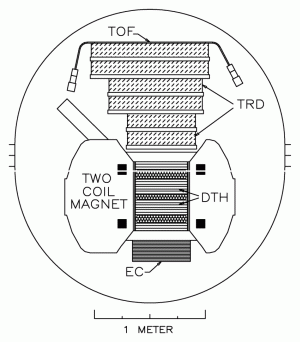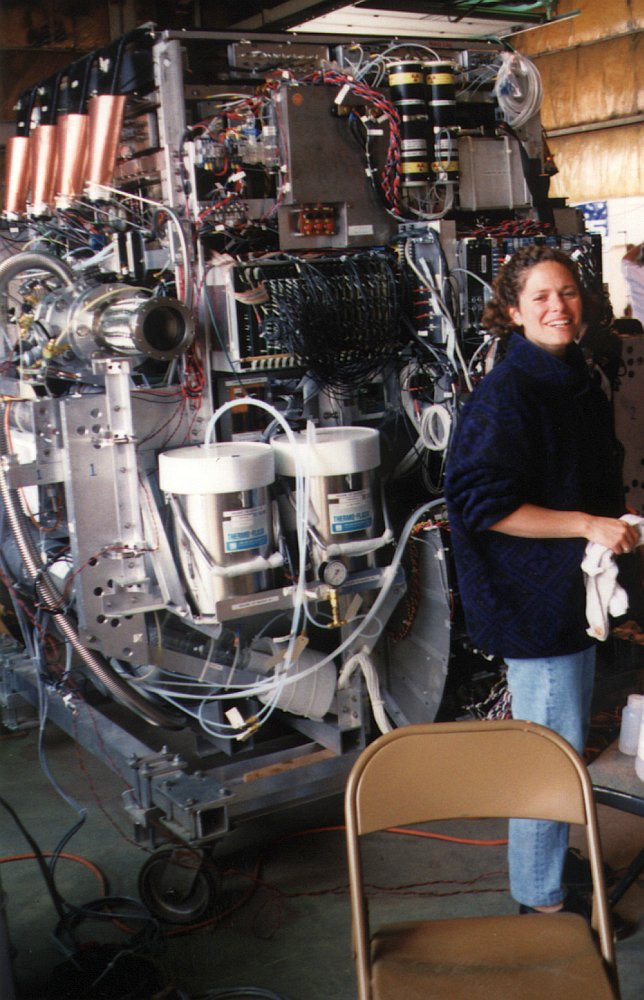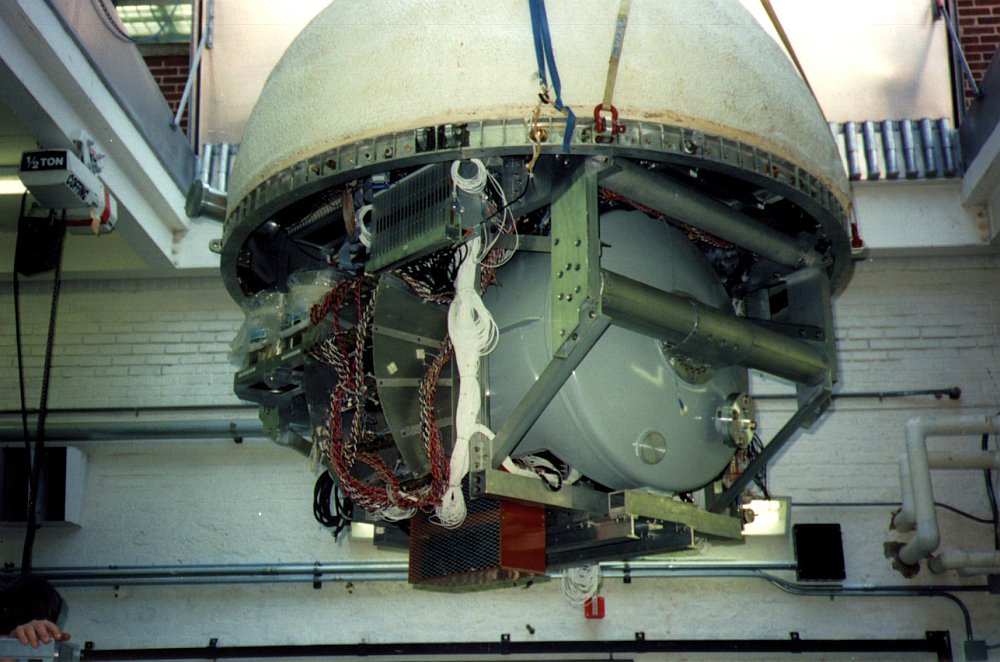Purpose of the flight and payload description
An instrument optimized for the detection and identification of cosmic-ray electrons and positrons at energies from about 1 GeV up to 50 GeV and beyond. It consists of a two-coil superconducting magnet and a precision drift-tube tracking hodoscope, complemented with a time-of-flight system, a transition radiation detector and an electromagnetic shower counter.
The superconducting magnet, with two circular Niobium-Titanium coils held at 4.2 K in a liquid-helium bath, provides an approximately uniform field of about 1 Tesla within a rectangular room-temperature bore measuring 51 cm x 51 cm x 61 cm. The cryostat employs a vapor-cooled radiation shield and superinsulation to isolate the inner helium vessel from the ~300 K environment. The total liquid helium capacity for the system is 260 liters, with a maximum hold time of ~7 days. The total system weight is 420 kg.
The drift-tube hodoscope (DTH) consists of 479 thin-walled drift tubes, each 2.45 cm in diameter, arrayed in 26 layers. Of these, 18 layers are aligned with the tube axes parallel to the magnetic field, and provide trajectory measurements used to determine rigidity. The remaining 8 layers, aligned with axes normal to the magnetic field, provide the additional information required to reconstruct trajectories in three dimensions. A drift gas based on CO2 with hexane as an organic quencher flows through the tubes. CO2 is used because it exhibits low diffusion as well as a slow drift speed. This ensures the minimum possible broadening of the electron cloud as it drifts towards the sense wire, resulting in improved single-point tracking resolution.
The hodoscope electronics are designed to measure the difference in time between the detection of an ionizing particle in a drift tube and a STOP pulse generated by the experiment trigger. The timing measurement represents the drift time for the first electrons produced by the ionizing particle that reach the anode wire, and corresponds to the distance of closest approach to the anode wire for the ionizing particle.
Given the large backgrounds present against the cosmic positron signal, mostly due to cosmic rays (CR) protons more abundant, or stray particles from the isotropic CR flux that enter the instrument from outside its field of view, a strong background rejection power is necessary. In the HEAT instrument this is done by combining the magnet spectrometer with a time-of-flight (TOF) system, a transition radiation detector and an electromagnetic shower counter, thus attaining an adecquate level of proton rejection.
The TOF system consists of four scintillators at the top of the instrument (each 100 cm x 25 cm x 1 cm) and the top three scintillator layers of the electromagnetic shower counter (each 50 cm x 50 cm x 1 cm). HEAT use Hamamatsu photomultiplier tubes (PMTs), which can be oriented along the fringe fields of the magnet such that gain losses are minimized. PMT anode signals are amplified and provide the experiment fast trigger (top-bottom coincidence) and are time and charge-digitized.
The particle's velocity is determined from the time-of-flight, utilizing the path length through the instrument obtained by extrapolation of the drift-tube track in the precisely known magnetic field. It's magnitude is determined by correcting the measured energy loss (proportional to the charge collected at the PMT anodes) in the top TOF counters.
A transition radiation detector (TRD) is particularly well-suited to discriminate between electrons and hadrons throughout the energy interval addressed by HEAT, where electrons and positrons produce saturated TR signals, while protons produce no TR.
The TRD is comprised of six modules, each consisting of a 12.7 cm-thick polyethylene fiber radiator viewed by a 2 cm-thick multiwire proportional chamber (MWPC). A gas mixture of 70% xenon and 30% methane flows through the MWPCs, for an efficient detection of TR photons, yet providing an ionization signal that does not dominate over the TR signal. Stretched aluminized mylar sheets provide cathode windows in which the aluminum is etched to form 7.8 cm-wide cathode "strips". The total charge deposited on these strips, and hence the total energy deposited in the MWPC, is pulse-height analyzed with 12-bit resolution.
Finally the electromagnetic shower counter (EC) is used to measure the electron energy and to complement the hadron rejection capability of the TRD (besides providing the bottom TOF measurement). The EC consists of 10 layers of 0.5 em-thick lead sheets (0.9 radiation length) interleaved with scintillator slabs (50 cm x 50 cm x 1 cm). The PMT anode outputs are fed into two pulse-height analysis and digitization chains operating at different gains. EC signals are used as part of the trigger system, where for a settable fraction of events, a minimum shower sum is required.
Details of the balloon flight
Balloon launched on: 8/23/1995 at 12:41 utc
Launch site: Lynn Lake Airport, Manitoba, Canada
Balloon launched by: National Scientific Balloon Facility (NSBF)
Balloon manufacturer/size/composition: Zero Pressure Balloon SF3-459.37-080-NSXCHR-ST
Balloon serial number: W39.57-2-09
Flight identification number: 395N
End of flight (L for landing time, W for last contact, otherwise termination time): 8/24/1995 at 12:49 utc
Balloon flight duration (F: time at float only, otherwise total flight time in d:days / h:hours or m:minutes - ): F 32 h
Landing site: 3 miles N of Tadoule Lake, Manitoba, Canada
After weeks of weather delays and when the scientific team was close to packing up and leaving without flying, the surface wind conditions became suitable for a launch attempt on the morning of August 23, 1995, just when the turnaround launch window was deteriorating. At 7:40 am local time, and using a heavy crane as launch vehcle, the balloon was airborne and reached float altitude of near 130.000 ft shortly after 10 am, after a nominal ascent phase. The flight developed flawlessly allowing the collection of very high quality data, and decision was taken to terminate the flight at noon the following day.
Unfortunately, overnight the weather had become very poor, with strong winds and pelting rain over the whole landing estimated area. However, as the balloon -that drifted 150 miles NE of Lynn Lake- was heading directly for Hudson bay -where it would have been lost- decision was made to terminate the mission despite the bad weather and the complicated terrain. The termination signal was transmited from the chase plane, and the payload separated from the balloon. Because the low visibility due to the severe rain storm, the plane had to rely on GPS bearings to follow the path of the instrument during the parachute descent. After it was determined that the payload had stopped descending, the chase plane had to drop to an altitude of a few hundred feet before finally sighting the instrument: it was floating in the surface of Tadoule Lake (would not sink as it was a vacuum closed sphere) and was getting dragged across the water by 40 knot winds that pushed the parachute like a huge sail.
Immediately, commands were sent to detach the parachute, but by the time it took effect, the instrument had hit land and was dragged several hundred feet on the ground. Most of the devices attached to the outside of the shell (batteries, transmitters, valves, etc...) were ripped away, and the shell itself was dented and even punctured in some places. It took until the next day before crews managed to reach the instrument by helicopter and started the recovery operation. Remaining external attachments were removed, and the instrument covered with a tarp. It took several more days before a heavy-lift helicopter was available for retrieving the instrument and bringing it back to Lynn Lake. From there it was loaded back onto its trailer and driven back to the US.
Althought the core of the instrument was almost intact, the outer shells were beyond repair. A sad outcome of the mission as these shells were built back in the 60's for the Luis Alvarez's research group at Berkeley, thus having a long and important history in Cosmic Ray research.
(taken from the field diary of one of the scientists of the project and enriched with aportations from Dr. Michel DuVernois)
This was the second mission of the instrument. The flight at higher latitudes (north of 56 degrees) allowed the scientists to record positrons of lower energies than the 1994 Fort Sumner flight, because of a smaller geomagnetic rigidity cutoff. Data was collected for nearly 26 hours at a mean atmospheric overburden of 4.8 g/cm2.
The performance was nominal, althought due to a voltage problem one of the six layers of the TRD was non-functional, as were a small number of drift tubes. Nevertheless, this not affected the data because during the post flight data reduction, the resulting slight losses of hadron rejection power were compensated by tightening the electron selection criteria.
External references
- Air Shower Muons and the Atmospheric Neutrino Puzzle 26th International Cosmic Ray Conference. Vol. 2, p.68
- Cosmic Antimatter article published on Scientific American, April 1998 - PDF format -
- Cosmic-Ray Positrons: Are There Primary Sources? Astropart.Phys. 11 (1999) 429-435
- Electron and positron energy spectra: HEAT magnet spectrometer results 26th International Cosmic Ray Conference. August 17-25, 1999. Salt Lake City, Utah, USA
- High-Energy Antimatter Telescope (HEAT): Basic Design and Performance at CiteSeer
- Measurements Of The Cosmic Ray Positron Fraction With The Heat Spectrometer at CiteSeer
- Measurements of the Cosmic-Ray Positron Fraction From 1 to 50 GeV at CERN
- NASA Balloon Flights (1989-1998) in NASA Historical Data Book, Vol. VII: NASA Launch Systems, Space Transportation, Human Spaceflight, and Space Science, 1989-1998
- The WiZard collaboration cosmic ray muon measurements in the atmosphere Nuclear Physics B - Proceedings Supplements - Volume 85, Issues 1-3, May 2000, Pag. 355
2279If you consider this website interesting or useful, you can help me to keep it up and running with a small donation to cover the operational costs. Just the equivalent of the price of a cup of coffee helps a lot.




